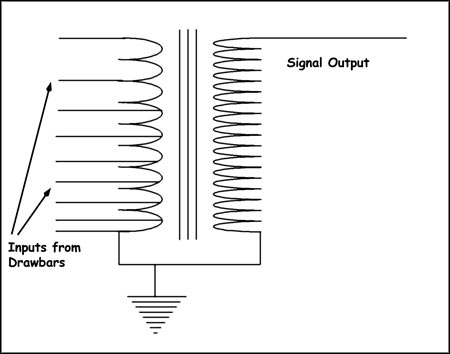The HAMMOND ORGAN
North Suburban HAMMOND ORGAN Service
Below is a schematic of a typical Hammond matching transformer. The primary winding has a relatively few turns of heavy wire and there are nine taps on the winding which are spaced logarithmically. The lowest tap is grounded, and the other successive taps represent increasing intensity levels, which you can see because the successive taps on the primary represent more and more turns of the primary winding. The signals from the harmonic controls on the console appear at various levels on the primary. They induce a corresponding signal in the secondary, which has many turns of finer wire.
Because the secondary has many turns of finer wire, it has a much high impedance than the primary side. This high impedance is much more compatible with the inputs of the preamplifier and that is why this transformer is referred to as a matching transformer, because it matches the low impedance of the tone generator and keyboards to the high impedance of the pre-amplifier input. In a typical Hammond console there are actually two matching transformers, one for the top keyboard, and one for the lower keyboard and also the bass pedals.

Figure 14. Typical Hammond organ matching transformer.
The reason for this is so that the musician can choose to have the vibrato effect on either keyboard independently. The very first Hammond organs had only a tremolo which affected the entire instrument. When the Hammond vibrato was developed, it similarly affected the entire instrument, but later on, the folks at Hammond devised the selective vibrato that the musician could place on either keyboard independently, giving him many more interesting tonal effects. Now, what exactly are tremolo and vibrato
Actually, there are several words which are sometimes used erroneously, so let's first clarify these terms.
Tremolo, Tremulant, Vibrato, Reverberation.
The first and third terms, Tremolo and Vibrato refer to regularly recurring qualities which affect the tones of any musical instrument. The second term, tremulant, is the mechanical device or circuit in either a pipe or an electronic organ which produces a tremolo, (and also vibrato in a pipe organ). The last term, reverberation, has nothing to do with any of the first three terms. But, because it sounds somewhat like the word vibrato, with its letters V, B, R; some people confuse it with vibrato, or use it erroneously when referring to what is actually vibrato. Reverberation is a prolongation of any sound which continues after the original sound has stopped. It is caused by repeated reflections or echoes of the original sound from the interior surfaces of a room or a hall, and generally increases in duration with increasing room size. It has no relationship whatever to vibrato, other than the above cited phonetic similarity.
Previous page Page 7. Next page